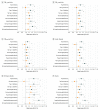Association of Long-term Exposure to Ambient Air Pollutants With Risk Factors for Cardiovascular Disease in China
- PMID: 30848806
- PMCID: PMC6484675
- DOI: 10.1001/jamanetworkopen.2019.0318
Association of Long-term Exposure to Ambient Air Pollutants With Risk Factors for Cardiovascular Disease in China
Abstract
Importance: Which cardiometabolic risk factors (eg, hypertension, type 2 diabetes, overweight or obesity, and dyslipidemia) are more sensitive to long-term exposure to ambient air pollution and whether participants with these conditions are more susceptible to the cardiovascular effects of air pollution remain unclear.
Objectives: To evaluate the associations among long-term exposure to air pollutants, cardiometabolic risk factors, and cardiovascular disease (CVD) prevalence.
Design, setting, and participants: This population-based cross-sectional study was conducted from April 1 through December 31, 2009, in 3 cities in Northeastern China. Participants were adults aged 18 to 74 years who had lived in study area for 5 years or longer. Data analysis was performed from May 1 through December 31, 2018.
Exposures: Long-term (2006-2008) exposure to air pollutants was measured using a spatiotemporal statistical model (particulate matter with an aerodynamic diameter of ≤2.5 μm [PM2.5] and ≤1.0 μm [PM1.0]) and data from air monitoring stations (particulate matter with an aerodynamic diameter of ≤10.0 μm [PM10.0], sulfur dioxide [SO2], nitrogen dioxide [NO2], and ozone [O3]).
Main outcomes and measures: Cardiovascular disease was determined by self-report of physician-diagnosed CVD. Blood pressure, body mass index, and levels of triglycerides and low-density lipoprotein cholesterol were measured using standard methods.
Results: Participants included 15 477 adults (47.3% women) with a mean (SD) age of 45.0 (13.5) years. The prevalence of CVD was 4.8%, and the prevalence of cardiometabolic risk factors ranged from 8.6% (hyperbetalipoproteinemia) to 40.5% (overweight or obesity). Mean (SD) air pollutant concentrations ranged from 35.3 (5.5) μg/m3 (for NO2) to 123.1 (14.6) μg/m3 (for PM10.0). Associations with air pollutants were identified for individuals with hyperbetalipoproteinemia (eg, odds ratio [OR], 1.36 [95% CI, 1.03-1.78] for a 10-μg/m3 increase in PM1.0) and the weakest association for those with for overweight or obesity (eg, OR, 1.06 [95% CI, 1.02-1.09] for a 10-μg/m3 increase in PM1.0). Cardiometabolic risk factors only partially mediated associations between air pollution and CVD. However, they modified the associations such that greater associations were found in participants with these cardiometabolic conditions (eg, ORs for CVD and per 10-μg/m3 increase in PM1.0, 1.22 [95% CI, 1.12-1.33] in participants with hyperbetalipoproteinemia and 1.07 [95% CI, 0.98-1.16] in participants without hyperbetalipoproteinemia).
Conclusions and relevance: In this population-based study of Chinese adults with CVD, long-term exposure to air pollution was associated with a higher prevalence of cardiometabolic risk factors, and the strongest associations were observed for hyperbetalipoproteinemia. In addition, participants with cardiometabolic risk factors may have been more vulnerable to the effects of air pollution on CVD.
Conflict of interest statement
Figures



Similar articles
-
Part 2. Association of daily mortality with ambient air pollution, and effect modification by extremely high temperature in Wuhan, China.Res Rep Health Eff Inst. 2010 Nov;(154):91-217. Res Rep Health Eff Inst. 2010. PMID: 21446212
-
Association of Breastfeeding and Air Pollution Exposure With Lung Function in Chinese Children.JAMA Netw Open. 2019 May 3;2(5):e194186. doi: 10.1001/jamanetworkopen.2019.4186. JAMA Netw Open. 2019. PMID: 31125097 Free PMC article.
-
Associations of air pollution, obesity and cardiometabolic health in young adults: The Meta-AIR study.Environ Int. 2019 Dec;133(Pt A):105180. doi: 10.1016/j.envint.2019.105180. Epub 2019 Oct 15. Environ Int. 2019. PMID: 31622905 Free PMC article.
-
A systematic review and meta-analysis of intraday effects of ambient air pollution and temperature on cardiorespiratory morbidities: First few hours of exposure matters to life.EBioMedicine. 2022 Dec;86:104327. doi: 10.1016/j.ebiom.2022.104327. Epub 2022 Oct 30. EBioMedicine. 2022. PMID: 36323182 Free PMC article.
-
[Breathing: Ambient Air Pollution and Health - Part II].Pneumologie. 2019 Jun;73(6):347-373. doi: 10.1055/a-0895-6494. Epub 2019 Jun 11. Pneumologie. 2019. PMID: 31185518 Review. German.
Cited by
-
Associations of Long-Term Exposure to Fine Particulate Constituents With Cardiovascular Diseases and Underlying Metabolic Mediations: A Prospective Population-Based Cohort in Southwest China.J Am Heart Assoc. 2024 May 21;13(10):e033455. doi: 10.1161/JAHA.123.033455. Epub 2024 May 18. J Am Heart Assoc. 2024. PMID: 38761074 Free PMC article.
-
Effects of PM2.5 exposure and air temperature on risk of cardiovascular disease: evidence from a prospective cohort study.Front Public Health. 2025 Jan 8;12:1487034. doi: 10.3389/fpubh.2024.1487034. eCollection 2024. Front Public Health. 2025. PMID: 39845671 Free PMC article.
-
Mediating effect of body fat percentage in the association between ambient particulate matter exposure and hypertension: a subset analysis of China hypertension survey.BMC Public Health. 2023 Oct 2;23(1):1897. doi: 10.1186/s12889-023-16815-0. BMC Public Health. 2023. PMID: 37784103 Free PMC article.
-
Association between ambient air pollutants and short-term mortality risks during 2015-2019 in Guangzhou, China.Front Public Health. 2024 Mar 4;12:1359567. doi: 10.3389/fpubh.2024.1359567. eCollection 2024. Front Public Health. 2024. PMID: 38500735 Free PMC article.
-
Changes in Life Expectancy of Respiratory Diseases from Attaining Daily PM2.5 Standard in China: A Nationwide Observational Study.Innovation (Camb). 2020 Nov 4;1(3):100064. doi: 10.1016/j.xinn.2020.100064. eCollection 2020 Nov 25. Innovation (Camb). 2020. PMID: 34557725 Free PMC article.
References
-
- Forouzanfar MH, Alexander L, Anderson HR, et al. ; GBD 2013 Risk Factors Collaborators . Global, regional, and national comparative risk assessment of 79 behavioural, environmental and occupational, and metabolic risks or clusters of risks in 188 countries, 1990-2013: a systematic analysis for the Global Burden of Disease Study 2013. Lancet. 2015;386(10010):2287-2323. doi:10.1016/S0140-6736(15)00128-2 - DOI - PMC - PubMed
-
- Li M, Qian Z, Vaughn M, et al. . Sex-specific difference of the association between ambient air pollution and the prevalence of obesity in Chinese adults from a high pollution range area: 33 Communities Chinese Health Study. Atmos Environ. 2015;117:227-233. doi:10.1016/j.atmosenv.2015.07.029 - DOI
Publication types
MeSH terms
Substances
LinkOut - more resources
Full Text Sources
Molecular Biology Databases
Miscellaneous

